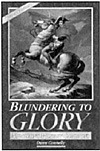
Author: Owen Connelly
Pages: 254
Illustrations: 1 black and white period portrait of Napoleon in 1797.
Maps: 32, all strategic or operational to show key movements and attacks
during battles and campaigns.
Footnotes: 43
Appendices: None, although one very long footnote outlines the
organization and evolution of the armies of Austria, Prussia, Russia and
Great Britain that fought against Napoleon.
Bibliography: 402 listings, divided into bibliographies and references,
primary sources, interpretive works, biographies, information on armies
and navies, and eight campaigns.
Index: 1559 entries
Publisher: Scholarly Resources, Inc., Wilmington, Delaware
Publication Date: 1999 (revised edition)
Binding: Cloth (hardbound) and Paper (softbound)
ISBN: 0-8420-2779-3 (hardback); 0-8420-2780-7 (paperback)
Price: $55.00 (hardback); $18.95 (paperback)
Summary: Blundering to Glory is an excellent primer or introduction to
Napoleon and his military impact on the era, and it also offers ideas to
challenge scholars and students of the period. Connelly's premise is
that Napoleon's superior intellect allowed him to adjust and improvise
to changing situations ("scramble") and thereby blunder to victory
against less capable opponents who eventually learned how to defeat the
master.
Lt.-Colonel Owen Connelly, US Army Rangers (Retired) holds an endowed chair of history at the University of South Carolina where he has taught since 1961. His major books include Napoleon's Satellite Kingdoms, The Epoch of Napoleon, French Revolution and Napoleonic Era, The Gentle Bonaparte: A Biography of Joseph, Napoleon's Elder Brother, and a revised edition of Blundering to Glory examined here.
In addition to his experience in the military, Connelly is an avid equestrian who also has insight into the use and importance of horses in the armies of the period [see interview in Napoleon #12]. Connelly's thesis is that although Napoleon did careful planning on movements to maximize his numbers, etc., he operated from an "engage, and then you wait and see" method on both a strategic as well as tactical level. Thus, he was often forced to improvise or "scramble" his way to victory — hence the title of the book.
As one example to support his argument, Connelly explains that Napoleon began "almost every campaign with a strategic blunder —- almost deliberately, as in 1805, when he overshot Mack at Ulm and had to double back to defeat him. Mistakes did not bother him. They were part of his system."
Connelly discusses the positive attributes of Napoleon's character that made him successful, such as his incredible energy and refusal to accept defeat, but he also criticizes Bonaparte's distortions of history and his egotism. You may disagree with Connelly, but as fellow historian David Chandler's review noted: "Whether this book entertains or (occasionally) infuriates, it makes a reader think."
The title of Connelly's book does not reveal that it includes summaries about Napoleon's youth, his family, his wives, important non-military events such as the coup of Brumaire, and his character. Unlike Campaigns of Napoleon and other massive works, Connelly's book covers a broad spectrum in a little more than 200 pages yet covers the major topics well. Plus it has one of the best bibliographies presented in any book — directing both new and experienced readers to key resources. (Interestingly, one salient omission in a bibliography that includes non-academics such as George Nafziger, Brent Nosworthy and James Arnold is Scott Bowden, whose archival order of battle work alone should have made his inclusion requisite.) These features, along with a very reasonably priced paperback edition, make Blundering to Glory an ideal book to give someone as a starting point into this exciting period of history.
Connelly's book provides a good overview to military operations, but it is not intended as a source for detailed orders of battle, etc. For example, he notes twelve battalions of Old Guard in the final attack at Waterloo compared to Peter Hofschröer's latest volume which identifies the specific routes of seven battalions against the Allied line. Also, the functional but uninspired maps are disappointing.
Despite these quibbles, Owen Connelly's Blundering to Glory deserves a place on everyone's Napoleonic bookshelf.
Napoleonic Library
-
Book Review: Eagles Over the Alps
Book Review: Napoleon and History Painting
Book Review: Napoleon's Elite Cavalry
Book Review: Napoleon in the Holy Land
Book Review: Napoleon and Austerlitz
Book Review: Blundering to Glory
Book News: Review Policy
Book Review: Followup: Greenhill Napoleonic Wars Data Book
Book Review: Errata for Swords Around the Throne
Back to Table of Contents -- Napoleon #15
Back to Napoleon List of Issues
Back to MagWeb Master Magazine List
© Copyright 2000 by Napoleon LLC.
This article appears in MagWeb (Magazine Web) on the Internet World Wide Web.
The full text and graphics from other military history magazines and gaming magazines are available at http://www.magweb.com
Order Napoleon magazine direct